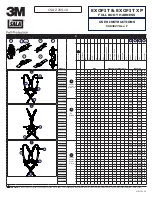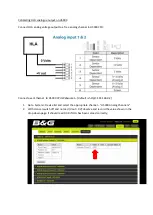
7.3 Optimising the static alignment
►
To optimise the static alignment, position the patient on the meas
uring device.
►
In the sagittal plane, check the course of the load line relative to
the marked alignment reference point and correct this if needed
(see Figure
6
on page 4).
►
In the frontal plane, check the course of the load line relative to
the marked points (prosthetic foot, prosthetic knee joint, spina ili
aca anterior superior) and correct if needed (see Figure
6
on
page 4).
7.4 Optimising during dynamic trial fitting
CAUTION
Adjusting the Settings
Fall due to incorrect or unfamiliar settings
►
Only adapt the settings to the patient gradually.
►
Explain the effects of the adjustments on the use of the prosthes
is to the patient.
Restore default settings
►
Prior to the dynamic trial fitting, restore the factory settings as
shown in the illustrations if the factory settings have been
changed (
7
,
8
and
9
on pages 5 and 6).
►
9
on page 6:
Adjust gradually,
Minimal braking action
When resetting, set the axis friction gradually (45°) to minimal res
istance to motion and then turn back slightly without creating
play .
Setting the load-related braking action (
10
on page 6)
►
Set the load-related braking action as shown in the illustration.
→
Increase threshold – Joint brakes at a higher load
→
Reduce threshold – Joint brakes at a lower load
►
Increase gradually (rotation: approx. 45° – 90°).
13
►
When the desired effect is reached, continue with "Setting axis
friction".
Setting axis friction (
11
on page 7)
►
Set the axis friction as shown in the illustration.
→
Decrease play – Increase resistance to motion
→
Increase play – Decrease resistance to motion
►
Reduce play and increase resistance to motion gradually (rota
tion: approx. 20°).
►
Set the load-related braking action and axis friction so that the
prosthetic knee joint switches from the stance phase to the swing
phase and no longer jams.
►
NOTICE!
To prevent increased wear and tear, do not use axis fric
tion to control the swing phase.
Setting the extension assist (
12
on page 7)
►
Set the extension assist as shown in the illustration if necessary.
→
Increase spring tension
→
Reduce spring tension
►
CAUTION!
Set the extension assist so that the lower leg of the
prosthesis swings through in the dorsal direction according to the
patient's requirements, but reaches full extension in time before
the next heel strike.
Fine-tuning the settings
►
CAUTION!
The various settings of the prosthetic knee joint can
not be adjusted entirely independently of each other. When the
settings cannot be fully adjusted to the comfort needs of the
patient, the settings should be established primarily based on
safety aspects.
►
Adapt the settings of the prosthetic knee joint to the patient by
means of fine-tuning and exercises.
Содержание 3R15
Страница 1: ...Instructions for use 10 15 3R15 3R49...
Страница 9: ...6 mm 634A58 Isopropyl alcohol 4B74 20 4X24 5 K 25 Nm 0 mm 9 Maintenance 15 9...
Страница 16: ...1 1 1 2 1 1 1 J 2 3R15 3R49 16 3R15 3R49 3 3 1 3 2 3R15 1 2 100 kg 1...
Страница 17: ...2 3 3 17 3 4 10 C 60 C 0 90 100 250 1100 3 5...
Страница 18: ...3 5 4 18 5 1 2 6 2 2 PSH DSH 7 7 1...
Страница 19: ...7 2 3 3 4 3 5 4 7 3 19 6 4 Spina iliaca anterior superior 6 4 7 4 7 8 9 5 6 9 6 45...
Страница 20: ...10 6 45 90 11 7 20 12 7 20 7 5 13 8...
Страница 21: ...7 5 1 3R6 3S106 8 8 1 21 8 2 1 2 3...
Страница 22: ...9 30 14 8 22 4B74 20 4X24 5 K 15 9 634A58 10 11 11 1...
Страница 23: ...11 2 2017 745 CE 23...










































